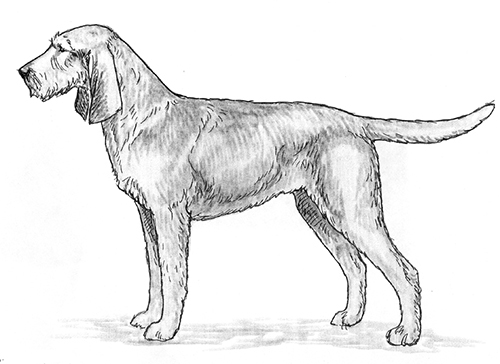Griffon Fauve de Bretagne
Scenthound Group
The goals and purposes of this breed standard include: to furnish guidelines for breeders who wish to maintain the quality of their breed and to improve it; to advance this breed to a state of similarity throughout the world; and to act as a guide for judges.
Breeders and judges have the responsibility to avoid any conditions or exaggerations that are detrimental to the health, welfare, essence and soundness of this breed, and must take the responsibility to see that these are not perpetuated.
Any departure from the following should be considered a fault, and the seriousness with which the fault should be regarded should be in exact proportion to its degree and its effect upon the health and welfare of the dog and on the dog’s ability to perform its traditional work.
History
The Griffon Fauve de Bretagne is one of the oldest of the French scenthound breeds. There was a pack in existence in the 14th Century. They were used to hunt wolves until those disappeared, then on hare, roe deer, fox and wild boar.
The Griffon Fauve de Bretagne was recognized by the United Kennel Club January 1, 1996.
General Appearance
Bony, muscular and active, the Griffon Fauve de Bretagne is a good endurance dog, resistant to weather conditions and suitable to difficult terrain.
Characteristics
Enterprising and efficient hunters, but also sociable, equable and affectionate with people.
Head
SKULL
The skull is rather long and slightly arched. It is widest between the ears, tapering towards the eyes. The occiput is prominent. The stop is only slightly marked.
MUZZLE
The muzzle tapers slightly from eyes to nose. The lips well cover the lower jaw but are not pendulous.
Serious Fault: Pendulous lips.
TEETH
The Griffon Fauve de Bretagne has a complete set of evenly spaced, white teeth meeting in a scissors bite. The absence of the first premolars is not a fault.
Disqualifications: Overshot or undershot.
NOSE
Black or dark brown, with well opened nostrils.
EYES
Dark brown in color, with tight rims and a lively expression.
Serious Fault: Light eyes.
EARS
Set on a line with the eye, the ears are finely attached, end in a point, are slightly turned, and reach just to the end of the nose.
Neck
Muscular, and rather short.
Forequarters
The shoulders are sloping.
FORELEGS
The elbows are in line with the body. The legs are straight, with good bone. The pasterns are slightly sloping.
Body
The chest is deep and broad, and the ribs are rather rounded. The back is short, broad and firm. The loin is broad and muscular, and there is only a slight tuck up.
Hindquarters
HIND LEGS
The legs are long and muscular. The hocks are well let down and moderately bent. The rear pasterns are vertical.
Feet
Compact, with tight, well arched toes and hard pads.
Disqualification: The presence of dewclaws.
Tail
Medium length and thick at the base, the tail is carried slightly sickle fashioned. It has bristly hair and swings from side to side when the dog is in action.
Coat
Very rough, harsh, and rather short. The face should not be too bushy.
Serious Faults: Woolly or curly coat. Sparse, smooth, fine coat.
Color
Any shade of fawn, from golden to red. A few black hairs are tolerated, as is a white star on the chest.
Height
Height at the withers for both males, and females is from 19 to 22 inches.
Gait
Supple and even, with no bounce.
Eliminating Faults
(An Eliminating Fault is a Fault serious enough that it eliminates the dog from obtaining any awards in a conformation event.)
Oversize or undersize.
Disqualifications
(A dog with a Disqualification must not be considered for placement in a conformation event, and must be reported to UKC.)
Unilateral or bilateral cryptorchid.
Viciousness or extreme shyness.
Albinism.
Overshot or undershot.
The presence of dewclaws.

Looking for a Dog?
Find a dog that will fit your family.
Note: The breeders on this list are not endorsed by UKC.
Revised July 1, 2009
©Copyright 1996, United Kennel Club
